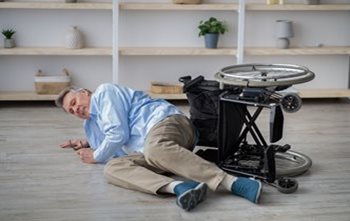
Fall Prevention: Fall Risk Monitoring Strategies
Falls are a major problem for patients* in hospitals and long-term care facilities. Some 3 to 20% of inpatients fall at least once during their hospitalization. In long-term care settings, up to 75% of
* The term ‘patients’ is used to refer to both acute care patients and long-term care residents.
In order to reduce the risk of falls, caregivers need to understand the conditions under which falls occur and the most frequent or common factors associated with fall risk. Approximately 10% of falls occur because of sudden medical illness (i.e., fainting or dizziness) or “accidental” trips and slips. In most instances, these falls cannot be predicted and, thereby, are not preventable. The majority of falls, however, are due to a host of underlying internal and/or external factors.
Questions? Check out our FAQs page and How Online IV Certification Works!
Objectives
Upon completion of this course, participants will be able to:
- List the reasons for fall risk monitoring.
- Describe the techniques for communicating fall risk.
- Explain the strategies for monitoring fall risk.
Curriculum
Chapter 1: Introduction
- Internal risk factors
- External risk factors
Chapter 2: Fall Risk Monitoring
- Determining Fall Risk Levels
Chapter 3: Communicating Risk
- Safety Education
- Flagging
- Safety Huddles
Hand Offs - Tools and Techniques to Assist in Handoffs
- Barriers to effective handoffs
Chapter 4: Monitoring Strategies
- High Fall Risk Conditions/Circumstances
- Safety Rounds
- Eyes and Ears Program
- Sitter Program
- Fall Alarms
Chapter 5: Deciding on Monitoring Strategies
- Summary
- California Bill 241
- Implicit Bias in Healthcare
- What is Implicit Bias?
- Implications of Implicit Bias in Healthcare
- How to Reduce Implicit Bias
Price: $12.00
Contact Hour: 1

Course Author

Rein Tideiksaar
Rein Tideiksaar, PhD, PA-C, or Dr. Rein as he is commonly referred to, is the president of Fall Prevent, LLC, Blackwood, New Jersey, a consulting company that provides educational, legal, and marketing services related to fall prevention in the elderly.
Dr. Tideiksaar is a gerontologist, which is a health care professional who specializes in working with elderly patients, and a geriatric physician's assistant. He has been active in the area of fall prevention for over thirty years.
Course Accreditation
See our Accreditation Statements page to view our accreditation information.